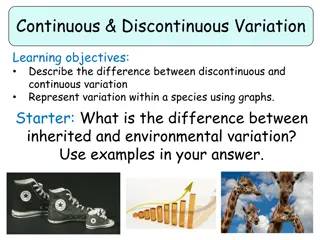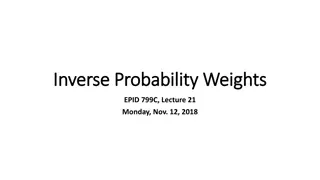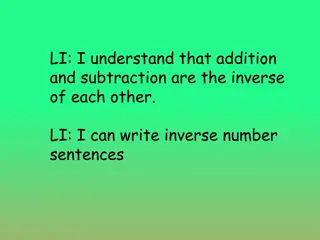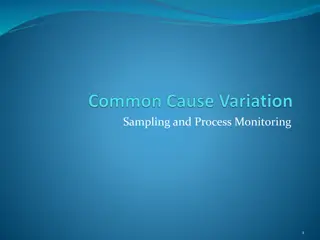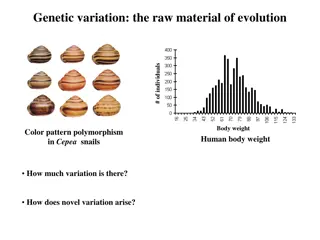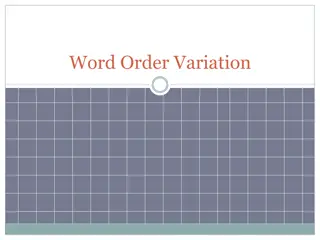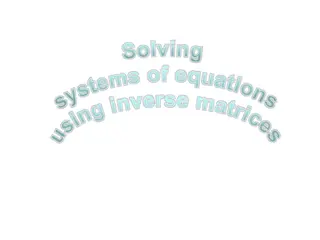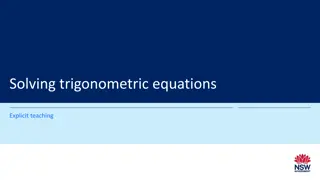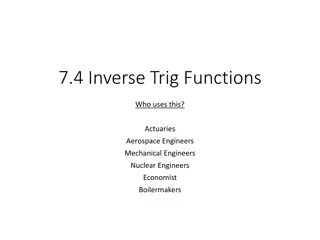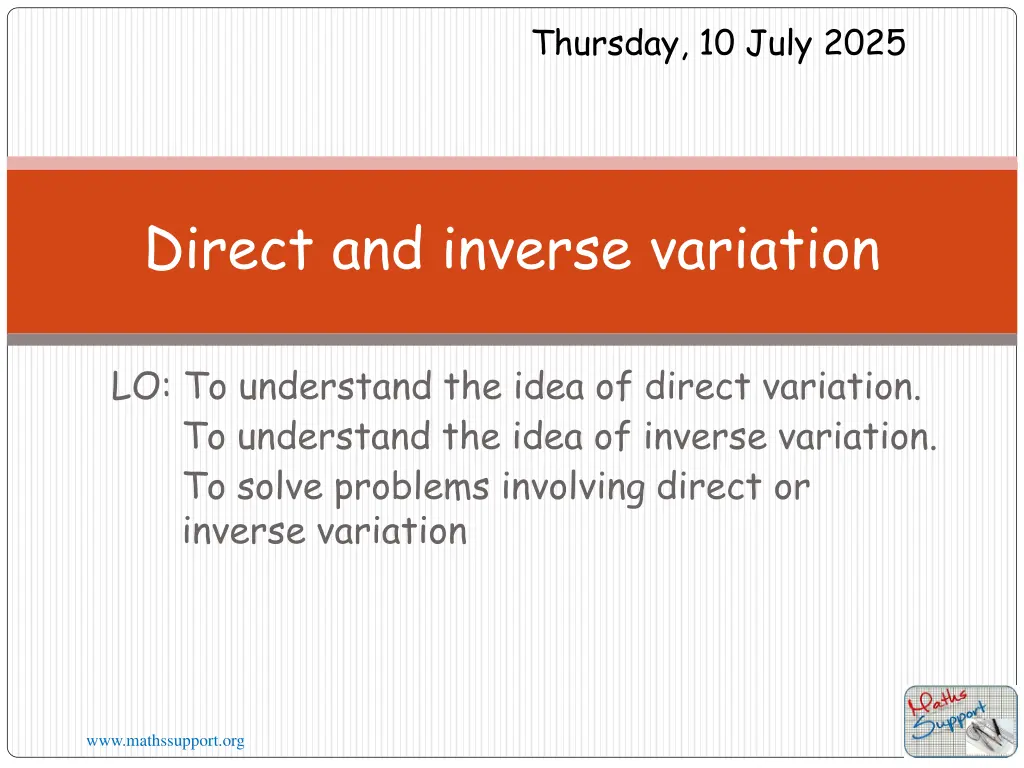
Understanding Direct and Inverse Variation
Learn about direct and inverse variation in mathematics, including how two quantities are related, the concept of proportionality, and solving problems involving direct or inverse variation. Explore examples illustrating direct variation with step-by-step solutions.
Download Presentation

Please find below an Image/Link to download the presentation.
The content on the website is provided AS IS for your information and personal use only. It may not be sold, licensed, or shared on other websites without obtaining consent from the author. If you encounter any issues during the download, it is possible that the publisher has removed the file from their server.
You are allowed to download the files provided on this website for personal or commercial use, subject to the condition that they are used lawfully. All files are the property of their respective owners.
The content on the website is provided AS IS for your information and personal use only. It may not be sold, licensed, or shared on other websites without obtaining consent from the author.
E N D
Presentation Transcript
Thursday, 10 July 2025 Direct and inverse variation LO: To understand the idea of direct variation. To understand the idea of inverse variation. To solve problems involving direct or inverse variation www.mathssupport.org
Direct and inverse variation When two quantities are related by a proportion, we say they are proportional to each other. Another way to express this relation is to talk about the variation of the two quantities. Is talking about how one number changes relative to another number. Variation could be either direct or inverse variation. In direct variation, as one number increases, so does the other. This is also called direct proportion. In inverse variation, it's exactly the opposite: as one number increases, the other decreases. This is also called inverse proportion. www.mathssupport.org
Direct variation stands for is proportional to . The symbol for variation is: (not to be confused with the Greek letter (alpha)) Two quantities x and y are said to be in direct proportion y x Writing the proportionality To change the proportion into an equation we replace by = k (equals k multiplied by) where k is the proportionality constant also called the constant of variation or constant of proportionality y= kx Writing the equation ? ?= k Rearranging for k Two quantities x and y are said to be in direct proportion if they increase or decrease together in such a manner that the ratio of their corresponding values remains constant www.mathssupport.org
Direct variation Example 1 The wages, (w) earned are proportional to the time (t) worked. If Peter worked 5 hours, he earned $36.25. (a) Write an equation for w in terms of t. (b) Find the wages after 40 hours of work. The first step is always to write the statement as a proportion using the variation symbol w t Writing the proportionality The second step is changing the proportion into an equation w= kt Writing the equation Substituting the given values to find k The equation for w in terms of t is 36.25= k (5) Replacing w and t w= 7.25t Rearranging for k 36.25 5= k k= 7.25 Solving for k www.mathssupport.org
Direct variation Example 1 The wages, (w) earned are proportional to the time (t) worked. If Peter worked 5 hours, he earned $36.25. (a) Write an equation for w in terms of t. (b) Find the wages after 40 hours of work. We use the formula found. w= 7.25t Knowing that t = 40 w= 7.25 (40) Substituting into the equation w= 290 Solving www.mathssupport.org
Direct variation Example 2 The distance, d metres, that a rock falls varied directly with the square of the time taken, t seconds. If the rock falls 6 metres in 2 seconds: (a) Write an equation for d in terms of t. (b) Find the distance the rock has fallen after 5 seconds. The first step is always to write the statement as a proportion using the variation symbol d t2 Writing the proportionality The second step is changing the proportion into an equation d= kt2 Writing the equation Substituting the given values to find k The equation for d in terms of t is 6= k (22) Replacing d and t d= 1.5t2 6 4= k k= 1.5 Rearranging for k Solving for k www.mathssupport.org
Direct variation Example 2 The distance, d metres, that a rock falls varied directly with the square of the time taken, t seconds. If the rock falls 6 metres in 2 seconds: (a) Write an equation for d in terms of t. (b) Find the distance the rock has fallen after 5 seconds. We use the formula found. d= 1.5t2 Knowing that t = 5 d= 1.5 (5)2 Substituting into the equation d= 37.5metres Solving www.mathssupport.org
Inverse variation In an inverse variation, as we stated before, as one number increases, the other decreases. This is also called inverse proportion. The symbol for variation is the same: Which stands for is proportional to . Two quantities x and y are said to be in inverse proportion y ? We read yis proportional to the inverse (reciprocal) of x To change the proportion into an equation we replace by = k (equals k multiplied by) 1 Writing the proportionality y=k1 Writing the equation ? y=? k= xy ? Rearranging for k www.mathssupport.org
Inverse variation Example 3 The number of hours (N) taken to build a wall varies inversely with the number of people (p) who are working on it. If 3 people are working building the wall, takes 2 hours to build. (a) Write an equation for N in terms of p. (b) Find the time it takes to build the wall if 4 people are working. (c) Given it takes 3 hours to build the wall, state how many people worked on it? The first step is always to write the statement as a proportion using the variation symbol N ? The second step is changing the proportion into an equation 1 Writing the proportionality N=? Writing the equation The equation for N in terms of p is ? Substituting the given values to find k 2=? k= (2)(3) = 6 Replacing N and p 6 ? N= 3 Rearranging and solving for k www.mathssupport.org
Inverse variation Example 3 The number of hours (N) taken to build a wall varies inversely with the number of people (p) who are working on it. If 3 people are working building the wall, takes 2 hours to build. (a) Write an equation for N in terms of p. (b) Find the time it takes to build the wall if 4 people are working. (c) Given it takes 3 hours to build the wall, state how many people worked on it? N= 6 ? We use the formula found. Knowing that p = 4 N=6 Substituting into the equation 4 N= 1.5 Solving It takes 1.5 hours to build the wall when 4 people work on it www.mathssupport.org
Inverse variation Example 3 The number of hours (N) taken to build a wall varies inversely with the number of people (p) who are working on it. If 3 people are working building the wall, takes 2 hours to build. (a) Write an equation for N in terms of p. (b) Find the time it takes to build the wall if 4 people are working. (c) Given it takes 3 hours to build the wall, state how many people worked on it? N= 6 ? We use the formula found. Knowing that N = 3 6 ? 3= Substituting into the equation p= 2 Solving 2 people work on it. www.mathssupport.org
Inverse variation Example 4 P is inversely proportional to the square of q. When q = 2, P = 12.8 (a) Write an equation for P in terms of q. (b) Find the value of P when q = 8 The first step is always to write the statement as a proportion using the variation symbol P 1 Writing the proportionality ?2 The second step is changing the proportion into an equation ? ?2 Writing the equation P= The equation for P in terms of q is Substituting the given values to find k ? 22 12.8= Replacing P and q P=51.2 ?2 k= (12.8)(4) Rearranging and solving for k k = 51.2 www.mathssupport.org
Inverse variation Example 4 P is inversely proportional to the square of q. When q = 2, P = 12.8 (a) Write an equation for P in terms of q. (b) Find the value of P when q = 8 P=51.2 We use the formula found. ?2 Knowing that q = 8 P=51.2 Substituting into the equation 82 P= 3.925 Solving www.mathssupport.org
Thank you for using resources from A close up of a cage Description automatically generated For more resources visit our website https://www.mathssupport.org If you have a special request, drop us an email info@mathssupport.org www.mathssupport.org

